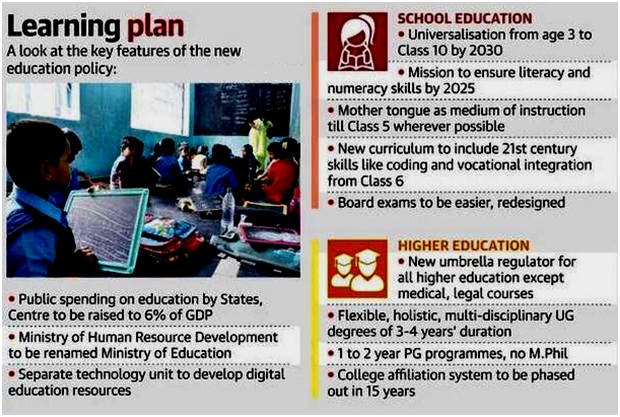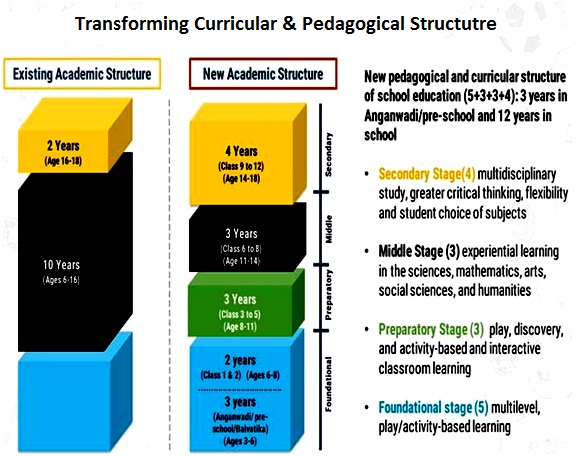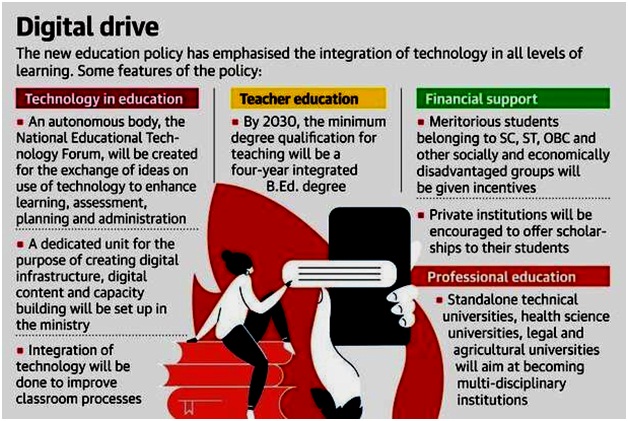National Education Policy-2020
- 31 Jul 2020
- On 29th July, 2020, the government approved the National Education Policy 2020, making way for large scale, transformational reforms in both school and higher education sectors.
- The Cabinet has also approved the renaming of the Ministry of Human Resource Development to the Ministry of Education.
- This policy will replace the National Policy on Education (NPE),1986.
Aim
- It aims to pave way for transformational reforms in school and higher education systems in the country.
- It aims for universalization of educationfrom pre-school to secondary level with 100 % Gross Enrolment Ratio (GER) in school education by 2030.
Evolution of Education Policy
- University Education Commission (1948-49)
- Secondary Education Commission (1952-53)
- Education Commission (1964-66) under Dr. D.S. Kothari
- National Policy on Education, 1968
- 42nd Constitutional Amendment,1976-Education in Concurrent List
- National Policy on Education (NPE), 1986
- NPE, 1986 Modified in 1992 (Program of Action, 1992)
- S.R. Subramaniam Committee Report (27 May, 2016)
- K. Kasturirangan Committee Report (31 May, 2019)
Important Highlights
School Education
Ensuring Universal Access at all Levels of School Education
- NEP 2020 emphasizes on ensuring universal access to school education at all levels i.e. pre-school tosecondary.
- Infrastructure support, innovative education centres to bring back dropouts into the mainstream.
- Facilitating multiple pathways tolearning involving both formal and non-formal education modes.
- Open learning for classes3,5 and 8 throughNational Institute of Open Schooling (NIOS).
- About 2 crore out of school children will be brought back into mainstream under NEP 2020.

Early Childhood Care &Education with new Curricular and Pedagogical Structure
- With emphasis on Early Childhood Care and Education, the 10+2 structure of school curricula isto be replaced by a 5+3+3+4 curricular structure corresponding to ages 3-8, 8-11, 11-14, and 14-18 years respectively.
- This will bring the hitherto uncovered age group of 3-6 years under schoolcurriculum, which has been recognized globally as the crucial stage for development of mentalfaculties of a child.
- The new system will have 12 years of schooling with three years ofAnganwadi/ pre schooling.
- NCERT will develop a National Curricular and Pedagogical Framework for Early ChildhoodCare and Education (NCPFECCE) for children up to the age of 8.

Attaining Foundational Literacy and Numeracy
- NEP 2020 calls for setting up of a National Mission on Foundational Literacy andNumeracy.
- States will prepare an implementation plan for attaining universalfoundational literacy and numeracy in all primary schools for all learners upto grade 3 by 2025.
- ANational Book Promotion Policy is to be formulated.
Reforms in School Curricula and Pedagogy
- There will be no rigid separations between arts and sciences,between curricular and extra-curricular activities, between vocational and academic streams.
- A new and comprehensive National Curricular Framework for School Education, NCFSE2020-21, will be developed by the NCERT.
Multilingualism and the Power of Language
- The policy has emphasized mother tongue/local language/regional language as the medium ofinstruction at least till Grade 5, but preferably till Grade 8 and beyond.
- Indian SignLanguage (ISL) will be standardized across the country, and National and State curriculummaterials will be developed, for use by students with hearing impairment.
Assessment of Reforms
- A new National Assessment Centre, PARAKH (Performance Assessment, Review, and Analysis of Knowledge for Holistic Development), will be set up as a standard-setting body.
Equitable and Inclusive Education
- NEP 2020 aims to ensure that no child loses any opportunity to learn and excel because of thecircumstances of birth or background.
- Special emphasis will be given on Socially andEconomically Disadvantaged Groups(SEDGs).
- This includes setting up of Gender Inclusion Fund and also Special Education Zones for disadvantaged regions and groups.
- Every state/district will be encouraged to establish “BalBhavans” as a special day-time boarding school, to participate in art-related, career-related, andplay-related activities.
Robust Teacher Recruitment and Career Path
- Teachers will be recruited through robust, transparent processes. Promotions will be merit-based,with a mechanism for multi-source periodic performance appraisals and available progression,paths to become educational administrators or teacher educators.
- A common National Professional Standards for Teachers (NPST) will be developed by the National Council forTeacher Education by 2022, in consultation with NCERT, SCERTs, teachers and expertorganizations from across levels and regions.
School Governance
- Schools can be organized into complexes or clusters which will be the basic unit of governanceand ensure availability of all resources including infrastructure, academic libraries and a strongprofessional teacher community.
Standard-setting and Accreditation for School Education
- NEP 2020 envisages clear, separate systems for policy making, regulation, operations andacademic matters. States/UTs will set up independent State School Standards Authority(SSSA).
- The SCERT willdevelop a School Quality Assessment and Accreditation Framework (SQAAF) throughconsultations with all stakeholders.
Higher Education
- NEP 2020 aims to increase the Gross Enrolment Ratio in higher education including vocationaleducation from 26.3% (2018) to 50% by 2035.
Holistic Multidisciplinary Education
- The policy envisages broad-based, multi-disciplinary, holistic Under Graduate education withflexible curricula, creative combinations of subjects, integration of vocational education and multiple entry and exit points with appropriate certification.
- UG education can be of 3 or 4years with multiple exit options and appropriate certification within this period.
- An Academic Bank of Credit is to be established for digitally storing academic credits.
- Multidisciplinary Education and Research Universities (MERUs), at par with IITs, IIMs, to beset up as models of best multidisciplinary education of global standards in the country.
- The National Research Foundation will be created as an apex body for fostering a strongresearch culture and building research capacity across higher education.
Regulation
- Higher Education Commission of India(HECI) will be set up as a single overarching umbrellabody for entire higher education, excluding medical and legal education.
- HECI to have fourindependent verticals - National Higher Education Regulatory Council (NHERC) for regulation,General Education Council (GEC) for standard setting, Higher Education Grants Council(HEGC) for funding, and National Accreditation Council(NAC) for accreditation.
Rationalised Institutional Architecture
- Higher education institutions will be transformed into large, well resourced, vibrantmultidisciplinary institutions providing high quality teaching, research, and communityengagement.
- Affiliation of colleges is to be phased out in 15 years and a stage-wise mechanism is to beestablished for granting graded autonomy to colleges.
Teacher Education
- A new and comprehensive National Curriculum Framework for Teacher Education, NCFTE2021, will be formulated by the NCTE in consultation with NCERT.
- By 2030, the minimumdegree qualification for teaching will be a 4-year integrated B.Ed. degree.
Mentoring Mission
- A National Mission for Mentoring will be established, with a large pool of outstandingsenior/retired faculty – including those with the ability to teach in Indian languages.
Open and Distance Learning
- This will be expanded to play a significant role in increasing GER. Measures such as onlinecourses and digital repositories, funding for research, improved student services, credit-basedrecognition of Massive Open Online Courses (MOOCs), etc., will be taken to ensure it is at par with the highest quality in-classprogrammes.
Technology in Education
- An autonomous body, the National Educational Technology Forum (NETF), will be created toprovide a platform for the free exchange of ideas on the use of technology to enhance learning,assessment, planning, administration.
- Appropriate integration of technology into all levels ofeducation will be done to improve classroom processes, support teachers’ professionaldevelopment, enhance educational access for disadvantaged groups and streamline educationalplanning, administration and management.
Promotion of Indian Languages
- To ensure the preservation, growth, and vibrancy of all Indian languages, NEP recommendssetting an Indian Institute of Translation and Interpretation (IITI), National Institute (orInstitutes) for Pali, Persian and Prakrit, strengthening of Sanskrit and all language departmentsin HEIs, and use mother tongue/local language as a medium of instruction in more HEIprogrammes .
Professional Education
- All professional education will be an integral part of the higher education system.
- Stand-alonetechnical universities, health science universities, legal and agricultural universities, etc. will aim tobecome multi-disciplinary institutions.
Adult Education
- Policy aims to achieve 100% youth and adult literacy.
Financing Education
- The Centre and the States will work together to increase the public investment in education sectorto reach 6% of GDP at the earliest.
Significance
- Built on the foundational pillars of Access, Equity, Quality, Affordability and Accountability, this policy is aligned to the 2030 Agenda for Sustainable Development.
- NEP 2020 is precisely what India needs to dominate in the future decades of growth, and drive the education requirements of our young population.
- Further, it aims to transform India into a vibrant knowledge society and global knowledge superpower by making both school and college education more holistic, flexible, multidisciplinary, suited to 21st century needs and aimed at bringing out the unique capabilities of each student.
Way Forward
- Education infrastructure is one of the important parameters which also needs a massive boost from the government authorities.
- The New Education Policy should have been implemented years ago to enable India's education system to catch up with that of other fast-developing nations in Asia.
- The focus on light government regulation, multidisciplinary institutions and creating equivalence of vocational and academic streams are welcome, but these have been a part of other countries' education models for years.
- It would have been good to have some more innovative ideas implemented like recognition of pathway/twinning programs with foreign universities, permission for for-profit firms to set up schools & colleges, allowing corporate CSR funding for primary research in universities and allowing universities to offer online degrees to outside their geographical jurisdiction.



